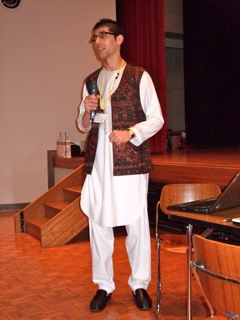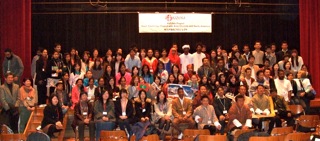Kizuna-Internatioなる
- At July 27, 2016
- By anneblog
- In Annes Letters
 0
0
Dear Family and Friends,
Did you know that during a major earthquake you should not turn off the gas? I had never realized the danger of that (because of an explosion) until I recently joined a Kizuna-Internatioなる joint program in Sendai. Kizuna’s subtitle is “Youth-Exchange Project with Asia, Oceania, and North America.” It is part of a national organization called JICE, or Japan International Cooperation Center. Internatioなる is a group promoting international relations between foreign and Japanese students here in Sendai. Impressively that local club was started last year by one of the undergraduates of Miyagi Gakuin Women’s University, where I teach.
Kizuna, which in Japanese means “to join”, encourages communication and unity between its members. Its purpose is for education and cultural exchange. The particular program I attended was sponsored by the Japanese government in an attempt to lessen people’s fears about the current situation in this country. Many foreigners have the idea that all of Japan is now dangerous due to nuclear fallout. They also tend to believe that no real progress has been made in hazardous areas. That of course means that business is down. Tourists do not want to come here and many governments are restricting the import of Japanese goods, especially agricultural and fisheries products.
The day of the Sendai workshop there were a total of about ninety students from nine Asian countries: Afghanistan, Bangladesh, Bhutan, India, The Maldives, Nepal, Pakistan, Sri Lanka, and of course, Japan.
(Afghanistan)








(Two Pakistan photos courtesy of Maajid Maqbool)
Prior to coming to Sendai that enthusiastic cluster of students had visited several places along the devastated northeast region of this country. In particular they had witnessed firsthand the destruction in Ishinomaki and the nuclear challenges in Soma, Fukushima. After Sendai they would go to Tokyo for a few days before returning to their home countries to teach others what they had learned while here.
On the day of the Sendai program, most participants wore traditional costumes, so the auditorium was vivid with colors and designs of all sorts. Speeches and presentations were in Japanese and English, with a rich variety of accents and intonation. The energy was alive and positive. Everyone wanted to learn as much as possible. So they listened attentively, asked questions eagerly, and expressed their opinions openly.


I had been asked to give a short speech. I told about my personal experiences, with special emphasis on how remarkable the Japanese had been and still were. I also mentioned my book Letters From the Ground to the Heart. Interestingly, afterwards several people came up to me and commented that was the first time they had heard about the remarkable attitude and behavior of the Japanese people after the March 11 tragedy. They pointed out that the people they had talked to tended to be very self-depreciating, so never mentioned themselves. Rather they stressed their gratitude for others’ assistance. I was pleased that they could see the Japanese in a very positive light. And I hope there will be better understanding and constructive work between Asian nations in the future.
After my talk there was a general discussion, and then a representative from each country said what they had learned so far during their stay in Japan. They also told us how they planned to use the information gained when they returned home.
Most said the same things in terms of safety measures during an earthquake:
Don’t run out of the building.
Protect your body, especially your head and torso.
Be sure of your own safety before helping others.
Only one group was astute enough to point out that staying in a building or not depended on the situation. In Japan the architecture is designed to be earthquake resistant, so staying inside might be the best option (but even then, not always). In other places getting out of buildings is essential for safety. For example, several Japanese students died in the New Zealand earthquake because they hovered inside buildings when they should have gone outside.
Another thing all the students said was that the nuclear danger was much less than they had believed. Before coming they had imagined the entire Tohoku region, if not all Japan, to be in serious trouble from fallout. But on this trip they learned that western Tohoku had not been touched by the disaster, except indirectly. And they could see that eastern Tohoku was slowly getting back on its feet.
The students had also been told that areas outside the Fukushima No-Go Zones were 100% safe. They had visited a farm with strawberries growing in greenhouses and could see that the plants were uncontaminated. However, from locals’ point of view that information is probably very questionable. Farmers as far away as Sendai report higher levels of radiation in their fields. It is slight, but still higher than before the nuclear problem. This was not mentioned in the workshop.
When these bright souls return to their countries, they hope to teach the people about the situation in Japan. They plan on using several methods: the Internet, Facebook, and social networking, of course. They will also use newspapers, magazines, and radios for more traditional methods. Also they will make T-shirts, bookmarks, and fliers in schools, and even hold parties and family gatherings to spread the word.
From what the students reported and how they behaved, it was easy to see their focus on and commitment to Asian unity. There was a sense of power and pride in being part this territory. And for many complex reasons, both obvious and subtle, Japan is wisely taking a lead in establishing goodwill between many countries in this vast and varied region of the world.





